|
An examination of journals of applied science today shows that many of
the authors refer to the original papers that Rayleigh wrote or, at least,
to the terms that attribute a phenomenon to his name. This occurs less
often for his contemporaries, in spite of the fact that many were influential
in extending the frontiers of knowledge by their original contribution
to the physical sciences. Rayleigh's work appears to have a timeless quality
that makes it relevent to any age.
A recent search through the INSPEC database, using the single keyword
`Rayleigh', produced the amazing result that some 15 000 papers, produced
over the last 20 years, had referred to some aspect of the 3rd or, latterly,
the 4th Baron Rayleigh's research
This paper aims to set out Rayleigh's `life and times', and to present
some examples of the way in which GEC is currently applying the results
of some of his researches.
Family History
The first direct ancestor of the Strutt family who can be reliably traced
is a John Strutt I, a corn miller, who settled in the Springfield area
of Chelmsford, Essex, in around 1667, working the Springfield and Moulsham
mills with his son John II. This branch of the Strutts continued as millers
until around 1727, when John retired to the small Essex village of Terling.
John II had, earlier in 1720, purchased the farm known as Simon Collins
in Terling. Thus began the Strutt's connection with that village and the
farming interests which continue to this day with the Rayleigh Estates.
Upon John II's death the property passed eventually to his grandson John
Strutt MP. After his marriage to Anne Goodday, the couple lived at Springfield
Place in Chelmsford, which he purchased in around 1758. This was latterly
owned by the Marconi Company and used as a training centre. Opportunely,
Sir Matthew Featherstonhaugh, Bart, chose to sell the manor of Terling
Place and the neighbouring estate of about 850 acres which John Strutt
MP purchased in 1761 for the sum of £18 540 12s 6d.
John Strutt MP built Terling Place, the family seat, in around 1772,
on land adjacent to the site of a former Palace of the Bishops of Norwich
(fig. 2). The house is built in white brick with a central block and two
wings which were added in 1820 by Joseph Holden Strutt. The west wing
was to house the laboratory of John William. Col. Joseph Holden Strutt,
inherited the estates on the death of John Strutt MP. In 1821 he was awarded
a peerage at the Coronation of George IVth for political services and,
unusually, asked that the honour be conveyed to his wife, the former Lady
Charlotte Mary Gertrude Fitzgerald, a daughter of James, 1st Duke of Leinster.
Thus, the Rayleigh title began with a Baroness.
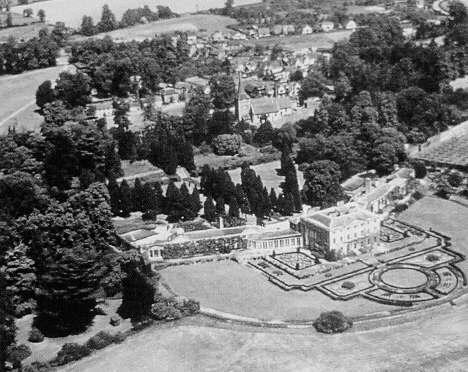
2 Terling Place
John James Strutt succeeded to the Barony at the death of his mother
in 1836. John James did not marry until his mid 40s and then, surprisingly,
to a young woman of barely 17 years of age, Clara Latouche Vicars. It
was to this couple that John William was born on the 12th of November
in 1842, the first of a family of seven children.
Early Life and Education
Although John William was to hold the highest honours the world of science
could bestow, early evidence of his genius was slow to appear as he was
almost three years old before he could talk! He would indicate by various
sounds and gestures to his mother that he wished an object of his attention
to be identified, bringing forth the prophetic remark from his grandfather
Col. Joseph Holden Strutt, `the child will either be very clever, or an
idiot'. However by his fourth year, his Aunt Emily was complaining that
he constantly pestered her with questions such as: `what becomes of the
water spilt on the tablecloth after it has dried up?' - evidence of an
inquisitiveness that was at the root of his genius.
He was sent to Eton when he was about 10 years of age. Although he was
enthusiastic to attend school his parents showed some trepidation in sending
him away so young. He was at Eton only a short while before contracting
smallpox. On his recovery he returned home, shortly to contract whooping
cough. His parents decided that so delicate a child should be educated
at home during an extended convalescence. The services of a tutor were
therefore employed to attend his early educational requirements at Terling
Place. On his recovery he was sent to a Mr George Murray at Wimbledon
Common. Here he obtained his groundwork in mathematics, trigonometry and
statistics.
He was obviously a pleasing pupil from remarks passed by Mr Murray when
he said, `it is not often a tutor has so easy and pleasant a duty to discharge
as to instruct such a pupil'. A short stay at Harrow followed when he
was 14. He contracted a chest infection there that left him critically
ill and he never returned. Bouts of ill health were to dog John William
throughout his life. On his recovery he was sent to the Rev G. T. Warner
at Torquay where he remained for four years. It was Rev Warner who endeavoured
to persuade John William to abandon his interests in mathematics to study
classics, but fortunately for science, without success.
At 14 his scientific gifts were developing. An early interest was in
electricity as evidenced by the `shocking coil' he used to good effect
on his sister Clara. He was also carrying out experiments with magnets
and experimenting with combinations of chemicals. His interest in photography,
then in its infancy, was encouraged by his mother who assisted him in
the photographic and processing operations. This laid the groundwork for
his classic work on the production of diffraction gratings and his definitive
paper on the pinhole camera. He was, in 1887, to describe a technique
for colour photography. The technique was subsequently refined by Lippmann
who was to gain the Nobel prize for his work in defining the process.
In 1861, James Clerk Maxwell had devised a process for colour photography,
but not with total success.
Trinity College Cambridge
John William entered Trinity College Cambridge in October 1861 as a fellow
commoner. This was customary for so-called `young men of fortune' (fig.
3). The additional fees paid for a distinctive academic gown, and as he
put it, `the doubtful privilege of dining at high table with the Dons'.
He had passed the entrance examinations with a considerable degree of
success. The tutors had been at some pains, however, to select questions
in the classics that would not tax his less-than-complete knowledge in
this area of study.
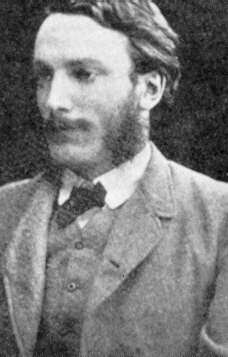
3 John William Strutt as a young man (self portrait)
His mathematics tutor was the excellent Dr E. J. Routh, and it was he
who was instrumental in developing John William's immense mathematical
gifts that underpinned his understanding of the physical sciences. During
his period at Trinity, John William attended the lectures of Sir George
Stokes, himself a senior wrangler and First Smith's Prizeman, honours
John William also attained. Stokes was Lucasian Professor of Mathematics,
a post held some 200 years earlier by Sir Isaac Newton, and today held
by Professor Stephen Hawking.
Whilst at Trinity, John William had met Arthur James Balfour, politician
and philosopher. Balfour was elected to Parliament in 1874 as member for
Hertford and later became Prime Minister from 1902-1905. He wrote a number
of books, perhaps the most well known are, `A Defence of Philosophical
Doubt' in 1879, and `Foundations of Belief', in 1894, a year incidentally
in which he was President of the Society for Psychical Research. The friendship
had brought John William into contact with Balfour's two elder sisters,
Evelyn and Eleanor. Eleanor was subsequently to assist John William in
his investigations on the development of electrical standards for the
ohm and ampere during his tenure as Professor of Physics at the Cavendish
Laboratory. He was to marry Evelyn in 1871.
John William graduated in 1865 gaining the distinction of Senior Wrangler,
and the award of First Smith's Prizeman for his submissions the following
year. Thus, at the age of 22, John William was regarded as a mathematical
physicist of great promise. The scientific legacy he was to leave justified
that promise in full measure
Areas of Research and Publications
John William Strutt, 3rd Baron Rayleigh left a scientific legacy of phenomenal
value.There were few areas of physics that he did not investigate.
Rayleigh's output was enormous, producing 446 papers spanning the years
1869 to 1920. The last three papers appeared after his death in 1919.
The papers were published in a variety of scientific journals including
the Philosophical Magazine, Nature, Proceedings of the Royal Society,
and the London Mathematical Society. They were bound into six volumes
latterly produced as three by Dover Publications in 1964. Rayleigh's classic
textbook, `The Theory of Sound', was produced in two volumes in 1877 and
1878. The volumes were printed by Dover Publications in 1945
Rayleigh has justifiably been called the last of the great Victorian
polymaths. He was to assist in the development of the great edifice of
nineteenth century physics, his contribution ranking with Stokes, Kelvin
and Clerk Maxwell.
The Cambridge Fellowship and
Early Researches at Terling
Following his return to Trinity to take up his Fellowship, he began to
study the scientific literature of the time. One of his professors suggested
he should learn German and he used Helmholtz's `Die Lehre von den Tonempfindungen',
published in 1862, as a means to study both the language and the work
of the great German physicist. This stimulated his interest in acoustics
and the physiology of hearing. Study of Helmholtz's papers on colour vision
and the work of Young and Maxwell were also influential in leading to
Rayleigh's own early experimental investigations in this area of physics.
He recognized the power and applicability of the approximate methods in
the development of mathematical models to study physical phenomena. Mathematical
methods developed by Lagrange in which energy and momentum are expressed
in terms of generalized coordinates were to prove of particular value
in his study of the dynamics of elastic continua, acoustics, optics and
electricity.
Rayleigh's view of the use of mathematical methods and approximations
appears in the preface of his classic text `Theory of Sound' recorded
here.
`In the mathematical investigations I have usually employed such methods
as present themselves naturally to a physicist. The pure mathematician
will complain, and (it must be confessed) sometimes with justice, of deficient
rigour. But to this question there are two sides. For however it may be
to maintain a uniformly high standard in pure mathematics, the physicist
may do well to rest content with arguments which are fairly satisfactory
and conclusive from his point of view. To his mind, exercised in a different
order of ideas, the more severe procedure of the pure mathematician may
appear not more but less demonstrative.'
One of the most important pieces of early research carried out at the
Terling laboratory consisted of his investigations into light scattering.
In 1870, John William was engaged upon experimental studies in connection
with colour and colour vision, aiming to replicate research by James Clerk
Maxwell. He observed during the series of experiments that different readings
were obtained when the sky was blue, compared to readings obtained when
the sky was overcast.
Following examination of the results from a series of experiments in
which he plotted the intensities of the spectra from the red to the blue,
he reasoned that small particles in the atmosphere somehow interact with,
and scatter, the sunlight incident upon them. John William was then to
derive mathematically the complete expression for the scattering of light,
presenting his results in his classical paper of December 1870, `On the
Light from the Sky - Its Polarization and Colour'. This confirmed that
the intensity of scattered radiation varies inversely as the fourth power
of the wavelength - a fact that Rayleigh had demonstrated earlier by dimensional
analysis. This pioneering work on the scattering of light by small particles
was later generalized by Gustav Mie and remains a fruitful area of scientific
research to this day.
The Laboratory and Research Work at Terling
Place
During his Fellowship period, Rayleigh had established a laboratory in
the west wing at Terling Place (fig. 4). An observation dome, built by
the 4th Baron for his studies of the night sky, is still in evidence today.
On his accession to the title and inheritance of Terling Place in 1873,
Rayleigh immediately set about improving the laboratory and facilities
for experimentation, hitherto comparatively crudely appointed. He installed
a private gasworks to provide gas for lighting, and for the bunsen burners
and blowtorch used in the manufacture of glassware.
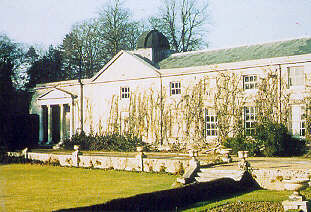
4 The laboratory wing at Terling Place
The laboratory complex consists of a study on the ground floor, known
as the `bookroom' (fig. 5), a workshop (fig. 6), and an adjacent room
fitted with a chemical bench and sink (fig. 7), part of this room being
partitioned to form a photographic darkroom. The room contained a turntable
on which could be placed a circular bath. The bath purchased from a local
ironmonger was used in Rayleigh's experiment to measure the diameter of
the oil molecule and also amongst others, to carry out observations on
fluid motion - the latter in connection with Rayleigh's researches into
solitary waves in the 1870s. The phenomenon of the solitary wave was first
noted by Scott Russell in 1834 and is now the subject of considerable
interest.
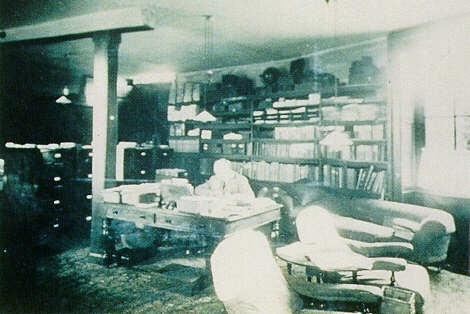
5 The study
The first floor contains the main laboratory, partitioned into a series
of areas including the `black room', used for optical experiments. A heliostat
was positioned on a pedestal outside the laboratory in order to direct
light into the black room - and beyond - for experiments requiring a long
beam of light. The laboratory was to be used as a camera when diffraction
gratings were employed, the grating being placed on a shelf some 25 ft
(7.5 m) from the shutter with a long focus lens in front forming an auto-collimating
spectroscope, a configuration he had learned from Clerk Maxwell.
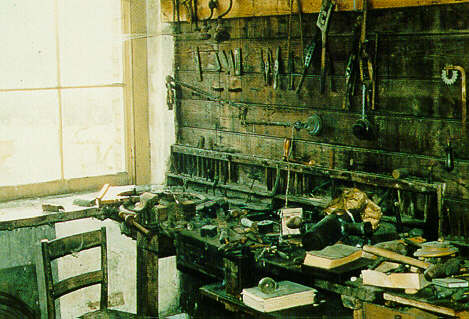
6 The workshop
Much of the experimental equipment, including glassware, was hand-made
either by Rayleigh himself or George Gordon, whom Rayleigh had persuaded
to join him from the Cavendish Laboratory. Rayleigh had a remarkable ability
to obtain results of fundamental importance, employing extremely simple
and - certainly by today's standards - crude apparatus (fig. 8). Lord
Kelvin, on one of his many visits to the laboratory at Terling, is on
record as saying that `everything appears to be held together with string
and sealing wax' (fig. 9).
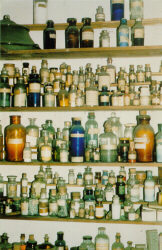 |
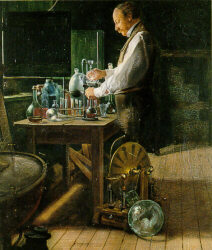 |
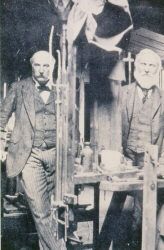 |
|
7 Rayleigh's 'chemistry
set'
|
8 Lord
Rayleigh in his laboratory
- a painting by Sir Philip Burne-Jones |
9 Rayleigh
and Kelvin at Terling Place,
July 1900
(from a photograph by
Prof. A. G. Webster) |
Work at the Cavendish Laboratory,
Cambridge
In December 1879, Lord Rayleigh was invited to become the second Cavendish
Professor of Physics, in succession to James Clerk Maxwell, and accepted
a five year tenure. Rayleigh appointed R. T. Glazebrook as demonstrator,
and who later became first Director at the National Physical laboratory.
Rayleigh also appointed Napier Shaw as demonstrator. Shaw later became
first Director at the Meteorological Office.
On the topic of electrical research, Rayleigh suggested to one of his
young research assistants, J. J. Thompson, that he determine the ratio
of the electrostatic unit to the electromagnetic unit. This had earlier
been attempted by Weber, Maxwell and William Thomson (later Lord Kelvin)
with limited success. Rayleigh designed parts of the apparatus himself
as reported in one of J. J. Thomson's first papers on this topic. This
phase of Thomson's work led to the discovery of the electron. During the
Cavendish period, Rayleigh was at the height of his powers writing some
sixty papers in the five year period, an average of one per month. In
describing Rayleigh's contribution to electrical research at the Cavendish,
J. J. Thomson stated that Rayleigh had changed `chaos into order'.
In December 1884 Rayleigh announced that he intended to resign his post
and return to private research work at his laboratory at Terling Place.
The Cavendish Laboratory became the foremost centre for Physics in the
late nineteenth and early 20th century. Twenty-five Cavendish physicists
have won the Nobel Prize, the first of which was awarded to Lord Rayleigh
himself in 1904 (fig. 10) for the discovery of argon (described later).
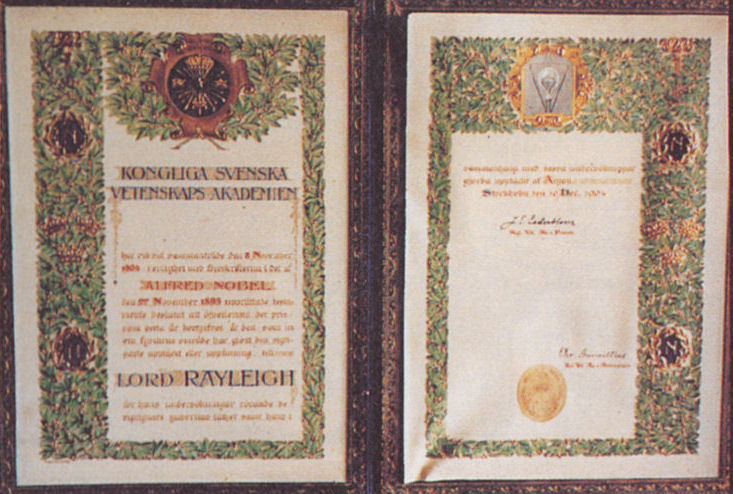
10 Rayleigh's Nobel prize citation
Work on Electrical Standards for
the Ohm
The ohm was defined in the mid 1860s using experimental equipment devised
originally by Lord Kelvin. This comprised a circular coil that was rotated
about a vertical axis, exerting thereby a magnetic force on a needle suspended
at the centre of the coil. If the coil rotated fast enough the deflecting
force was virtually steady permitting the angular deflection of the needle
to be measured. The angle depends upon the diameter of the coil, the rate
at which it spins, and the electrical resistance of the coil, in turn,
controlling the current flow. The experiment had been conducted in 1863-64
at King's College London under the auspices of the British Association.
The results of the committee's work was the specification of the standard
resistance coil used to represent 1 ohm. Subsequent to these experiments
doubt had been cast on the accuracy of the results following work by Kohlraush
(1874) who had found it to be 2% too great. Work by Rowland (1878) had
alternatively found it to be 1% too small. Weber also in 1878 had substantially
confirmed the original value. Whilst the value of the ohm remained uncertain
it was difficult to estimate the efficiency of electrical equipments.
Whilst Rayleigh was at the Cavendish he decided to re-examine the standard
for the ohm using the original apparatus, devised by Lord Kelvin. A critical
feature of the experiment was the speed control for the rotation of the
coil. Rayleigh used an electrically-driven tuning fork and circularly-calibrated
card attached to the spinning coil to confirm that the rotational speed
coincided with the frequency of oscillation of the tuning fork. A secondary
needle was introduced to monitor the effects of changes in the direction
of the Earth's magnetic field.
Early trials were carried out in the summer of 1880. The experiments
were conducted late at night to avoid magnetic and other perturbations.
Rayleigh regulated the speed, Dr Schuster took the main readings and Eleanor
Sidgwick (formerly Eleanor Balfour) recorded the readings of the auxiliary
magnetometer. Initial errors were caused, to some extent, by the ambiguous
definition of the coil dimensions in the original British Association
committee specification. Most of the 1.1% discrepancy could be traced
to the erroneous value of inductance that arose therefrom. The results
from the series of experiments were presented in a paper published in
early 1882. Rayleigh's value for the ohm was later adopted by the UK Board
of Trade and, in August 1893, by an international conference in Chicago.
The National Physical Laboratory at
Teddington (NPL)
Early interest in the need to establish a national scientific laboratory
in the United Kingdom was mooted at a meeting of the British Association
for the Advancement of Science in 1868, when Alexander Strange presented
a paper `On the necessity for state intervention to secure the progress
of physical science'.
In his Presidential address to the British Association in 1895, Douglas
Galton urged the importance of establishing such a laboratory in the United
Kingdom. A committee was set up by the British Association under the Chairmanship
of Galton with the `scientifically eminent and politically influential'
Lord Rayleigh as one of the committee members to `consider the establishment
of a National Physical Laboratory for the more accurate determination
of physical constants and for other quantitative research'. A deputation
of committee members, which included Lord Rayleigh, presented their deliberations
to the Prime Minister of the day, Lord Salisbury (Lady Rayleigh's uncle!)
The Government was subsequently to set up a committee of enquiry under
the Chairmanship of Lord Rayleigh to consider and report on the desirability
of establishing such a laboratory.
The committee report, dated 6th of July 1898, recommended the setting
up of a National Physical Laboratory under the control of the Royal Society.
Financial aid, voted by Parliament for putting the committee's conclusions
into effect, amounted to £4 000 as a grant in aid of expenses and
£12 000 towards the erection of suitable buildings. The council of
the Royal Society appointed Lord Rayleigh as Vice Chairman of the General
Board and Chairman of the Executive Committee. At a Committee meeting
held on the 5th July 1899 a letter was read from Dr R. T. Glazebrook,
who had expressed his willingness to undertake the Directorship of the
Laboratory. Dr Glazebrook's appointment was approved by the President
and Council of the Royal Society and he undertook his duties as first
Director from 1st January 1900.
Rayleigh was to continue actively in the affairs of the NPL until his
death in 1919.
Professorship at the Royal Institution
The Royal Institution of Great Britain in Albermarle Street, London,
had been founded by Count Rumford in 1799 under Royal patronage. Rumford
was a colonist, soldier and a scientist of some note who had founded the
Institution to bring `the improvement of life through demonstration'.
Rayleigh was invited to accept the Professorship of Natural Philosophy
in succession to John Tyndall in 1887, a post he was to hold until 1905.
Rayleigh gave over 100 research lectures during his tenure.
It is of interest to note that Guglielmo Marconi attended a lecture presented
by Rayleigh on electromagnetic propagation. Marconi wrote to Rayleigh
requesting a copy of the lecture notes to which he wished to refer in
preparation for his Nobel presentation (fig. 11). Marconi also wrote to
Rayleigh inviting him to Cornwall to view the propagation experiments
that were later to confirm Marconi's theory that electrical transmission
over large distances was indeed possible.

11 Marconi's letter to Rayleigh concerning his
Nobel lecture
Select image for an enlargement
Towards the end of 1880, Rayleigh's interest turned to surface physics,
surface tension and capillarity. His measurement of the diameter of the
olive oil molecule exemplifies his direct approach to experimental science.
It was in Rayleigh's mind that the molecular diameter could be determined
by the measurement of the thickness of an oil film, judged to be one molecule
thick. The apparatus featured in the experiment comprised a 33 inch (82.5
cm) diameter sponge bath obtained from a local ironmongers. Having filled
the bath with water a succession of oil droplets were deposited on the
surface aimed at determining the volume of oil just sufficient to cover
the surface of the water. The extent of the spreading film of oil was
monitored by noting the activity or quiescence of particles of camphor
deposited around the rim of the bath on the initially uncontaminated surface
of the water. In this simple manner Rayleigh was to determine the thickness
of the oil film and hence the molecular diameter of the oil molecule as
40.6 µinches (1.6 nm). Later experimenters using somewhat
more elaborate methods have confirmed Rayleigh's result to within a few
percent. Rayleigh's measurements were the first direct attempt to measure
the dimensions of a molecule.
Rayleigh was to divide his time between the Royal Institution and his
Laboratory at Terling Place. The experiments for the isolation of argon
were a case in point, with the initial reduction being carried out at
the Royal Institution and the final production carried out at Terling
Place.
The Isolation of Argon and the Nobel
Prize
The isolation of the inert gas Argon was one of Rayleigh's most famous
accomplishments and led to his award of the Nobel Prize. William Prout
had earlier suggested, in 1815, that atomic weights were exact multiples
of hydrogen. If Prout was right, the exact density of oxygen relative
to hydrogen should have been 16 and not 15.96, the value commonly accepted
at that time. Rayleigh started to examine this anomaly by conducting experiments
himself on the relative densities of oxygen to hydrogen. A succession
of experiments yielded the ratios 15.89, 15.882, 15.880, and 15.863.
Rayleigh then began to examine the properties of nitrogen. Using two
samples of nitrogen - one prepared from ordinary air with the oxygen removed
by exposure to red hot copper and a second sample obtained by the decomposition
of ammonia - resulted in two different values, as detected by the weighings.
In order to obtain information from research chemists he wrote a letter
to Nature, dated the 29th September 1892 stating,
`I am puzzled by some results on the density of nitrogen, and shall
be obliged if any of your chemical readers can offer suggestions as to
the cause. According to the method of preparation I obtain two quite distinct
values. The relative difference, amounting to 1/1000 part, is small in
itself, but it lies entirely outside the errors of experiment, and can
only be attributed to a variation of the character of the gas'.
Rayleigh then spent some two years preparing nitrogen samples by several
techniques, however the nitrogen produced artificially was always lighter
than nitrogen produced from the atmosphere by about 0.5 percent. The consistency
of the results produced by different processes led Rayleigh to the view
that the problem lay in the existence of some constituent in the atmospheric
nitrogen that had remained, as yet, undetected. Professor Dewar the physical
chemist, a colleague at the Royal Institution, suggested that Rayleigh
refer to work, dating from 1795, by Henry Cavendish, who had himself experimented
with the reduction of atmospheric nitrogen.
Henry Cavendish's experiments of some hundred years earlier had relied
upon a primitive spark machine to oxidize the atmospheric nitrogen. Rayleigh
was to use this technique, carrying out the initial work at the Royal
Institution and completing the final reduction at the Terling laboratory.
Rayleigh had received correspondence from Professor Ramsay, a chemist
at University College London, who had himself begun to examine the characteristics
of the atmospheric nitrogen using magnesium as a reagent following Rayleigh's
earlier publication of his initial findings. This was regarded by many
at the time as a breach of scientific etiquette. Correspondence of the
day indicates that Ramsay kept Rayleigh informed of his progress in the
isolation of the gas. The efforts by Ramsay had put Rayleigh under some
pressure to complete his experiments more rapidly than he would have preferred.
A joint paper entitled, `Argon, a New Constituent of the Atmosphere',
was presented at a meeting of the Royal Society on 31st January 1895.
The findings were not universally accepted by the chemical fraternity
at the time. Certain criticisms pointed to the fact that so heavy an element
could not possibly be a gas. Rayleigh's reply was characteristic:
`The result is no doubt very awkward.... and all we can do is apologize
for ourselves and the gas'.
For this work Rayleigh was to be awarded the Nobel Prize for Physics
in 1904. In that same year, Ramsay was awarded the Nobel Prize in Chemistry
for his work on the isolation of argon and helium and, with Travers, the
other noble gases neon, krypton and xenon.
Rayleigh and the Quantum Era:
Black Body Radiation and the Rayleigh-Jeans Law
Rayleigh was to do fundamental work on black body radiation towards the
end of the nineteenth century. This led to an expression determining the
precise wavelength distribution of black body radiation as a function
of absolute temperature. The expression Rayleigh derived (qualified by
Jeans) fitted observation at long wavelengths. Wien alternatively had
proposed a law that fitted the observations at the shorter wavelengths.
Unlike Wien's law, however, the Rayleigh-Jeans Law was based rigorously
on classical physics, and involved no arbitrary constants. Its failure
to describe aberrations highlighted the limits of classical theory and
was not resolved until Max Planck produced his classical paper in 1901.
This introduced the revolutionary idea that energy is emitted in packets
or quanta, and became the foundation of quantum theory.
Rayleigh seemed reluctant, however, to bridge the gap between classical
and quantum physics. Although he had read Bohr's fundamental papers on
the quantum theory of atomic physics with great interest, he was reluctant
to accept the radical type of thinking that contravened the known laws
upon which the edifice of nineteenth century physics was based. Rayleigh
refused to participate directly in the theoretical developments that led
to modern quantum mechanics, although his work was influential in guiding
those who were to make contributions in this area of theoretical development.
Latterday Applications of Lord Rayleigh's Scientific Research
Industrial Applications of Argon
The inert gas argon of course has many applications in industry today.
The inability of the gas to react with other substances makes it suitable
for use in applications such as welding, where it is used as a shield
to inhibit oxidation of the molten metal; in nuclear reactors, as an inert
cooling agent; in electric light bulbs; and in lasers. The gas is also
used in the manufacture of semiconductor crystals where an inert atmosphere
plays an important part in the process.
Surface Acoustic Wave Devices
The year 1885 saw the publication of Rayleigh's paper, `On Waves Propagating
Along the Plane Surface of an Elastic Solid', in the Proceedings of the
London Mathematical Society. This single paper has resulted in the development
of a number of fields of application, with both industrial and defence
potential. These include, for example, propagation, ultrasonic microscopy,
nondestructive testing and optical guided waves.
One such application is in the development of what are known as dispersive
surface acoustic wave delay lines, that have their principal application
in pulse-compression radar systems. They are used both for generation
of an IF chirp pulse, which drives the frequency conversion and amplification
chain of the transmitter and, relatedly, for compression of the received
chirp pulses into short pulses of equivalent bandwidth. The process is
equivalent to a Fourier transformation and, therefore, similar devices
may be used in spectrum analysis for so-called compression receivers.
A further application is in the construction of nondispersive, broadband,
continuously-variable delay modules that have application in target simulation.
Delay lines are normally designed to meet specific applications, as the
wide range of parameters and the complexity of the specification makes
it impractical to manufacture and stock standard ranges. In the majority
of cases, the parameters given refer to a pair of lines consisting of,
first, an expander designed to generate a down-chirp of duration equal
to at least the dispersive delay quoted as a requirement, and second,
a compressor to match the pulse. In all cases the input and output circuits
are designed to be tuned to specific bandwidths. The sidelobe weighting
is obtained from a combination of tuning, variation of aperture of the
transducers and also from the chirp phase law (in the case of non-linear
units).
Custom-designed surface acoustic wave devices have been produced by the
GEC-Marconi Research Centre (MRC) for the GEC-Marconi product divisions
(fig. 12). One such SAW device, namely a dispersive delay line, has been
produced in production quantities for GEC Avionics. The filter set was
custom designed for the pulse compression radar system used in the Tornado
aircraft for target detection and missile delivery.
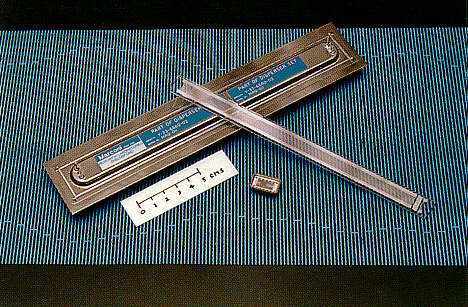
12 Surface acoustic wave (SAW) device
Design of Antenna Systems
The Rayleigh statistical distribution finds many applications in the
radio propagation field. For example, deviations from a pure Rayleigh
distribution in the case of the signal amplitude received via tropospheric
scatter permit conclusions to be drawn about layer formation in the troposphere.
The relative strengths of the Rayleigh and log-normal components in atmospheric
radio noise permit the separation of the propagation conditions, for example,
from lightning and other phenomena (see Beckmann).
The ultimate sensitivity of a microwave receiving system is determined
by thermal noise (see Scanlan). Thermal noise is emitted by any body which
is above absolute zero and not completely transparent to the wavelength
of interest.
The Rayleigh-Jeans formulation for black body radiation can be used to
express the radiated noise power for an antenna system for all radio frequencies
and also for the lower microwave frequencies. It fails to satisfy the
conditions for the shorter wavelengths. Planck's equation for black body
radiation, dating from 1901, provides a relationship that satisfies the
observed behaviour throughout the complete frequency range.
In measuring the radiation pattern of an antenna of, say, diameter D,
it is required to establish how close a remote test source can be placed.
If the range is too short, the electromagnetic field will not have developed
fully to the form possessed at infinity. The transition to the far field
occurs gradually and is conventionally completed at the Rayleigh Distance,
R = 2D2/  , where , where
 is the wavelength. At this distance the difference in path length from
the source to any point on the aperture plane has diminished to
is the wavelength. At this distance the difference in path length from
the source to any point on the aperture plane has diminished to  / 16.
This definition is generally adopted when designing antenna systems, although
it is, in fact, four times greater than the value given in Rayleigh's
1881 paper `On images formed without reflection or refraction', based
on a phase error of / 16.
This definition is generally adopted when designing antenna systems, although
it is, in fact, four times greater than the value given in Rayleigh's
1881 paper `On images formed without reflection or refraction', based
on a phase error of  / 4. / 4.
When placing the source in the so-called far-field, use is made of the
image of the source in the ground, by equalizing the phases of the direct
and reflected signals. For satisfactory operation of such a `ground reflection
range', the smoothness of the ground should satisfy the `Rayleigh criterion'
that variations in the reflected phase should not exceed  /
4 in the neighbourhood of the reflection point. The term `Rayleigh criterion'
is perhaps better known as a definition of the resolving power of a telescope
in terms of its aperture: two incoherent sources are considered to be
resolved when their focal plane diffraction patterns are positioned such
that the peak of one falls in the first null of the other. This is equivalent
to an angular separation of 1.22 /
4 in the neighbourhood of the reflection point. The term `Rayleigh criterion'
is perhaps better known as a definition of the resolving power of a telescope
in terms of its aperture: two incoherent sources are considered to be
resolved when their focal plane diffraction patterns are positioned such
that the peak of one falls in the first null of the other. This is equivalent
to an angular separation of 1.22  / D
for a circular aperture. Illustrations of antenna systems and radio telescopes
developed at the GEC-Marconi Research Centre are shown in figs. 13 and
14. / D
for a circular aperture. Illustrations of antenna systems and radio telescopes
developed at the GEC-Marconi Research Centre are shown in figs. 13 and
14.
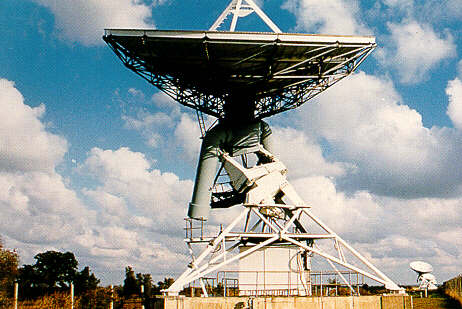
13 One of the eight antennas forming the Cambridge
5 km interferometer
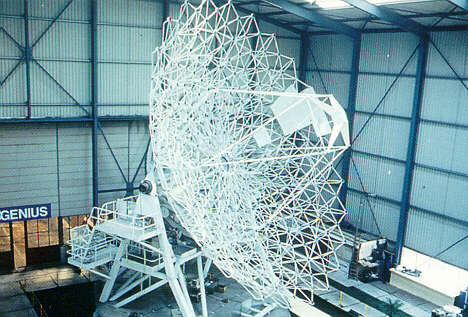
14 The James Clerk Maxwell telescope, now located
at Mauna Kea in Hawaii
and used for studying distant radio sources
Natural Convection Studies
Rayleigh's studies of convection in fluids are extensively cited in literature
pertaining to heat transfer. The so-called `Rayleigh number', Ra,
expressed in terms of the Grashof (Gr) and Prandtl numbers (Pr),
Ra = Gr.Pr, provides a measure of the behaviour of the fluid in the
laminar and turbulent regimes for the buoyancy-induced flows. Turbulent
flow can be expected for a Rayleigh number greater than 109,
for example, a condition associated with heat transfer from a heated surface
to a cooling fluid.
Work carried out on convective flows at MRC has been used for the assessment
of the cooling of electronic packaging configurations, consisting of assemblies
of printed circuit boards, and also for cooling studies of high-powered
electronic devices using, in some instances, a perfluorinated liquid as
the cooling medium. Convection studies have been carried out using the
FloSys computational fluid dynamics program, based on the finite domain
method (fig. 15). This technique reduces the governing differential equations
(Navier-Stokes and momentum) to a set of algebraic equations that can
be solved on the computer in terms of the fluid velocity vectors and pressures
for each cell. The technique is an approximation and the order of accuracy
of the solution reflects the refinement embodied within the mesh. Some
numerical experimentation is required, therefore, in order to confirm
the accuracy of the solution.
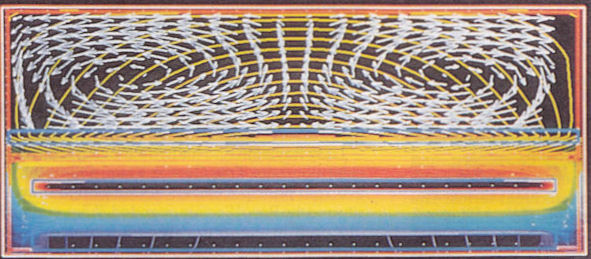 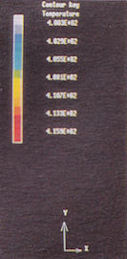
15 Results of FLOTHERM simulation of a power supply
unit, showing temperature contours and air velocity vectors on a cross-section
through the power supply
(courtesy of Flomerics Ltd.).
Scattering from Atmospheric Particles
The characteristics of radiation that is Rayleigh scattered from atmospheric
particles can be used to determine several properties of the atmosphere.
In particular, work is presently being carried out at MRC to measure windshear,
that is, the velocity of sudden updraughts and downdraughts (see fig.
16). These are of particular importance for aviation, since encountering
this form of turbulence during take-off or landing can, in extreme circumstances,
cause an aircraft to crash.
A windshear sensor operates by detecting the Doppler shift of radiation
scattered by particles in the atmosphere. This gives their velocity, and
a high rate-of-change of velocity with position is indicative of a dangerous
downdraught.
Scattering of light from particles can strictly only be called Rayleigh
scattering if the particles are small compared with the wavelength. Thus
if microwave radar is used, any radiation detected will be caused by Rayleigh
scattering, because atmospheric particles are typically a few microns
in diameter. Although windshear detection has been demonstrated using
microwave radar, there are certain advantages to be gained by using a
shorter wavelength; work at MRC is based around the use of a 2.1 µm
eye-safe laser and therefore involves Mie scattering. Nevertheless, the
principles of a windshear sensor using Rayleigh or Mie scattering are
the same.
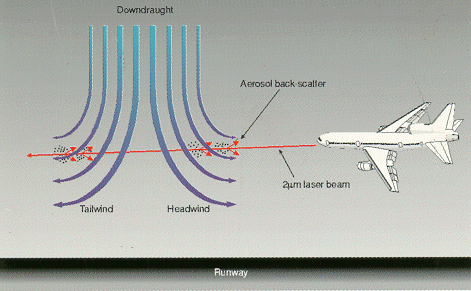
16 Principle of forward-looking windshear sensor
using solid-state laser
Solitary Waves
In 1834, Scott Russell, a Scottish engineer observed that the sudden
deceleration of a canal barge set in motion a wave that remained consistent
in height, wavelength and waveform for a considerable distance from the
point of disturbance. The phenomenon caused some interest at the time,
and both the French physicist Boussinesq, and Lord Rayleigh were, independently,
to describe the phenomenon in mathematical terms. The wave could be represented
as the solution to a particular class of non-linear differential equation.
The equation arises in a variety of applications ranging from the transmission
of light in optical cables to the motion of the Earth's continental plates.
Zabusky and Kruskal were to solve the equation numerically in 1965, dubbing
the solution of the solitary wave equation the soliton.
An interesting characteristic of the wave motion is the retention of
the single wave characteristics following interaction between two such
waves. Drazin comments in his paper that the waves appear to interact
as elementary particles such as electrons or protons. The mathematical
solution of the equation was proved by Kruskal et al. to have a form equivalent
to that of the Schrödinger wave equation. Further applications are
emerging, with applications in the description of planetary atmospheres
and waves in stratified fluids.
Over recent years, as Drazin states, solitons have become important in
many applications and no doubt will grow in importance as the scientific
and commercial relevance of the applications become evident (see, for
example, Kubota et al.).
Concluding Comments
That Terling, a small village in the English County of Essex, was the
home of one of the greatest nineteenth century physicists and Nobel Prizewinner,
John William Strutt, 3rd Baron Rayleigh, is known to few people. The laboratory
exists in a form which is virtually unchanged in layout since 1873. An
experiment set up by the 4th Baron, Robert John, to examine the behaviour
of active nitrogen remains as a silent witness to the fundamental work
that was carried out within the laboratory.
Lord Rayleigh died on the 30th of June 1919 from a heart attack in his
77th year. His health had begun to fail some months earlier, although
his scientific output had remained undiminished. He produced five papers
in 1918 and seven in 1919. Some five days before his death he had dictated,
to Lady Rayleigh, the closing paragraphs of a paper on cyclones for publication
in the Philosophical Magazine.
Rayleigh's funeral was at Terling, where he is buried in a corner of
the chuchyard that adjoins Terling Place (fig. 17). The simple monument
of red sandstone bears the inscription:
`For now we see through a glass darkly but then face to face.'
Lady Rayleigh and his two surviving sons were chief mourners. King George
V sent a representative, and principal officers of Cambridge University
and the Royal Society attended. Villagers lined the path to the church
door. A memorial to Rayleigh was placed in Westminster Abbey, in St Andrew's
Chapel. The inscription reads:
`An unerring leader in the advancement of natural knowledge'
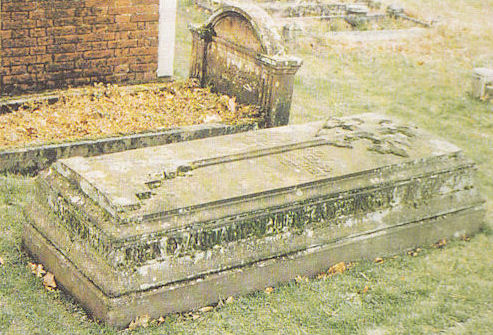
17 Rayleigh's grave
Acknowledgements
The author extends his grateful thanks to John, the Sixth Baron Rayleigh
for giving his permission to photograph various artifacts at Terling Place
for reproduction in this article. Sincere thanks are also due to the Hon.
Guy Strutt for his kind hospitality and numerous discussions, over a number
of years, pertaining to the life and times of John William Strutt, and
for the loan of books and publications.
Thanks are also extended to Mrs B. J. Gruhn for research on the history
of the Strutt family and making available material from lectures presented
at various historical association meetings
Thanks are also gratefully made to Dr John Howard for supplying a copy
of the facsimile of Paper No. 8, `On the Light from the Sky, its Polarization
and Colour, Itek Corporation, in addition to the copy of the report he
produced for the Rayleigh Archives Dedication Ceremony. Reference has
also been made to microfilmed copies of the Rayleigh correspondence prepared
by John Howard and deposited at the Lyon Playfair Library at Imperial
College, London - thanks are due to the library staff at that establishment.
The author gratefully acknowledges information supplied by colleagues
at the GEC-Marconi Research Centre
Bibliography
ASH, A. E., and PAIGE, E. G. S., Editors, `Rayleigh-Wave
Theory and Application', Proc. of an International Symposium Organized
by The Rank Prize Funds at The Royal Institution, London 15-17 July, 1985
Springer-Verlag.
BARRELL, H., `The Rayleighs and the National Physical
Laboratory, Applied Optics, 3, 10, pp. 1125 and 1128, October
1964.
BECKMANN, P., `Probability in Communication Engineering',
Pub. Harcourt, Brace & World Inc., 1967.
DRAZIN, P., `The life of a solitary wave', New Scientist,
November 1991.
HEY, J. D., `From Leonardo to the graser: light scattering
in historical perspective', Part II, South African Journal of Science,
79, August 1983.
HOWARD, J. N., `John William Strutt, Third Baron Rayleigh',
Applied Optics, 3, 10, October 1964, .
HOWARD, JOHN N. (Editor), `The Rayleigh Archives Dedication',
Special Report No. 63, AFCRL-67-0266, April 1967.
HUMPHREY, A. T., `John William Strutt, Third Baron Rayleigh
- The Last of the Great Victorian Polymaths', publication in preparation.
ISTED, G. A., `Guglielmo Marconi and the history of radio',
GEC Review, 7, 1 - 2, 1991.
KLEIN, M. J., `Max Planck and the beginnings of the quantum
theory', Archive for History of the Exact Sciences, 1, 1962
LINDSAY, R. B., `Lord Rayleigh - the Man and His Work',
Oxford, London, 1970.
KUBOTA, H., YAMADA, E. and NAKAZAWA, M., `A new technique
for optical soliton communication', NTT Review, 3, 6, p.
64-67, 1991.
MILLER, R. J., `A coherent model of radar weather clutter',
Proceedings of IEEE 1988 National Radar Conference, University of Michigan,
Ann Arbor, 88 CH 2572-6/88/0000-0246, IEEE, 1988.
MORTLEY, W. S., `Pulse compression by dispersive gratings
on crystal quartz', The Marconi Review, 28, fourth quarter,
1965.
RADCLIFFE, S. N., `Computer-aided design of interdigitated
transducers for Rayleigh-surface-wave lines', Internal publication, GEC-Marconi
Research Laboratories, circa 1973.
SCANLAN, M. B. J., `The design and measurement of large
microwave antennas', GEC Review, 4, 2, 1988.
SCHUSTER, A., `John William Strutt, Baron Rayleigh, 1842-1919',
obituary notice, Proc. Roy. Soc., 98A, 1921.
STRUTT, JOHN WILLIAM, BARON RAYLEIGH, `The Theory of
Sound', Vol.1 (1877) and Vol.2 (1878), London. Dover, 1945.
STRUTT, JOHN WILLIAM, BARON RAYLEIGH, Scientific Papers:
Vol.1 (1869-1881), Vol.II (1881-1887), Vol.III (1887-1892), Vol.IV (1892-1901),
Vol.V (1902-1910), Vol. VI (1910-1919). Also Dover Publications 1964,
printed as three volumes.
STRUTT, ROBERT JOHN, `Life of John William Strutt, Third
Baron Rayleigh OM., FRS', University of Wisconsin Press, New Edition 1968.
Foreword by John N. Howard, originally published by Edward Arnold and
Co., 1924.
STRUTT, HON. CHARLES R., `The Strutt Family of Terling
1650-1873', privately printed, 1939.
STRUTT, HON. G., `Vicars', (An account of the Vicars
family of Leix and Carlow), The Irish Ancestor, Vol.II, No. 2,
1970.
STRUTT, HON. J. W., `On the Light From the Sky, its Polarization
and Colour', facsimile of paper No. 8 from the Scientific Papers of Lord
Rayleigh, first published in the Philosophical Magazine, Dec 1870. Reproduced
from the original handwritten draft, Itek Corporation USA.
Surface acoustic wave dispersive delay lines, GEC-Marconi
Research Centre Techbrief No. 315.
THOMPSON, J. J., `Lord Rayleigh O.M., FRS', obituary
notice, Nature, 103, No 2593, July 1919.
TRECIOKAS, R., `Application of forward-error correction
to a Rayleigh fading HF communication channel, Proc. IEE, 125,
3, March 1978.
WOOD, P. J., `Near-field defocussing in the pencil beam
Cassegrain antenna', The Marconi Review, XXXVI, 191, fourth
quarter, 1973.
|